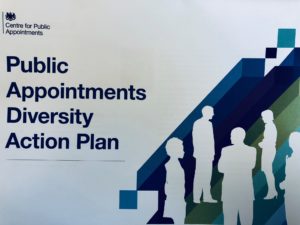Centre for Public Appointments’ Diversity Action Plan
Thursday 14 December 2017

Everyone agrees about the desirability of the goals. The ‘how’ is what matters. The Cabinet Office’s ‘Public Appointments Diversity Action Plan’ offers both the right ambitions for broadening diversity and sets out some sensible practical steps for achieving them.
The record of the past few years offers clear pointers. Considerable progress has been made in appointing women candidates- nearly a half of new appointments, and around 45 per cent when reappointments are included, up from a third five years ago. That did not just happen by accident. It reflected a deliberate and sustained commitment by ministers and departments, insisting on women being included on short lists for interviews and for a balance of appointments when a batch of board members were being appointed. The public sector drive for more women matched a series of private sector initiatives.
The key was to persuade women that serving on the board of a public body was interesting and attainable and not just, or primarily for, 60 plus year old white men. This has involved reducing in-built biases in the application processes such as forms requiring an off-putting list of specifications reflecting longstanding experience and focussing more on ability, while ensuring that all interview panels have at least one or two women on them. While progress has been made among board members, there are no grounds for complacency, not least since only about three in ten chairs of the boards of public bodies are women.
The trends are going in the right direction, though more patchily, for ethnic minorities. Depending on the measure used, roughly one in ten appointments go to ethnic minorities, compared with their 14 per cent share of the overall population. Moreover, only 4 per cent of chairs are from ethnic minorities. The broad category of ethnic minorities conceals big variations in the experience of people from different origins. While there are not detailed statistics, anecdotal evidence suggests that people with a south Asian background have held more public appointments than those with an African or Caribbean background. My own conversations since becoming Commissioner have indicated the need for much greater contacts between departments and public bodies and ethnic minority groups, to increase knowledge of what public appointments involve and about the application process, and to provide support and mentoring for potential candidates.
Against that background, the Government’s ambitions that by 2022, 50 per cent of all public appointees should be female and 14 per cent of new appointments should be from ethnic minorities are reasonable and should be achievable with commitment and effort. The two goals are different since the former refers to the stock or composition of all non-executive appointments on boards, while the latter is about the flow of new appointments being made, and is likely to be achieved ahead of an ambition defined in terms of stock. Moreover, the proposals in the ten point action plan for achieving these goals reflect what has worked in the past such as increasing the visibility of appointees from under-represented groups, developing pools of talent (as some departments are already doing), mentoring and encouraging boards to be more inclusive in their work. As I have previously noted, NHS Improvement has developed a promising initiative to encourage future board members via its NExT Director Scheme.
Yet the Government needs to go further in at least three respects. First, the record on disability is inadequate, although the data is poor, not least because people may be less inclined to declare whether they have a disability than their gender or ethnicity. At present, just 5 per cent of those who provided data recorded a disability, compared with 18 per cent of the UK’s working age population. The Government is not setting a quantified ambition here and is establishing a review of the barriers to those with disabilities taking up public appointments to report by next September. This is an area which I intend to focus on more in the hope of ensuring that the disabled are not neglected and put in the ‘too difficult’ box.
Second, ministers and departments need to do more not just to increase the diversity of boards but also, in particular, of their chairs. This will take time but requires active succession planning and mentoring of potential talented future candidates for chairs.
Third, the Government needs to look at social, geographic and age diversity. Public appointments are spread across the country, not least because of those made by the devolved adminstrations, as well as the locally based NHS trusts, Independent Monitoring Boards ( for prisons) and Parole Boards. But it is unclear where the members of national public bodies live, or their social backgrounds. Moreover, appointments are often not paid or only paid a relatively small amount, certainly by comparison with the private sector. That means that a high percentage of applicants, and of appointees, require secure incomes and are mostly aged 55 and over. There are still too few people appointed in the 35 to 45 age group.
I am glad to see the Cabinet Office is committed to improving the quality of the statistics and, next year, for the first time, I will be reporting on appointments made to LGBT people and those from faith communities.
The Action Plan recognises that diversity produces better functioning and more responsive boards. But achieving its ambitions will not just happen. It will require sustained will on the part of ministers, departments and public bodies.
I am struck by how Permanent Secretaries frequently celebrate increased diversity in the civil service at events and on social media: I think it is time to do the same for public appointments.
ends

